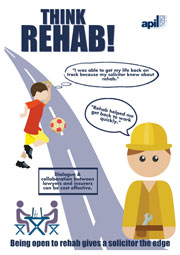Think Rehab!
Using the Code and the Best Practice Guidance to get the most for injured people
Early rehabilitation can often make a significant difference to an injured person’s recovery. In my experience as a personal injury solicitor, the NHS with its long waiting lists is not adequate to meet all of the rehabilitation needs of an injured person to give them the best chance of recovery.
In a case where liability is admitted, an application can be made for an interim payment at an early stage to fund any rehabilitation required. Things are not so straight forward in a case where liability is denied and an interim payment is unlikely. Having said this, it is in the interests of both the Claimant and the Defendant to a claim that the injured person begins their recovery as soon as possible following the injury. This will benefit the Claimant in getting the treatment and assistance they need as soon as possible giving them the best chance of recovery. It will also benefit the Defendant by potentially reducing the value of the claim if the Claimant’s condition improves.
A personal injury claim is intended to put the injured person in the position they would have been, were it not the accident. Compensation at the end of the claim is a poor substitute for a person’s health and so it is rehabilitation, rather than compensation, that will give the injured person the best chance of getting their pre accident life back.
Rehabilitation Code
The Association of Personal Injury Lawyers (APIL) contributed to the preparation of the Rehabilitation Code 2007, which provided a framework within which the legal representatives involved in a personal injury claim could work together in order to assess the rehabilitation needs of the Claimant at an early stage, and where appropriate, action those recommendations in an effort to assist the Claimant to return to their pre accident state as far as is possible.
The Code is recognised within the Pre action Protocol, although following the Code is not mandatory.
To accompany the Code, APIL prepared the Best Practice Guide on Rehabilitation, 2nd edition in 2008. In April 2015, the Guide was updated again with the 3rd edition of the Best Practice Guide on Rehabilitation. The new update is a must read for any personal injury practitioner, but I aim in this blog to highlight the main changes to the Guide and how it can be used in conjunction with the Code to get the most for our injured clients.
What is new?
The new code includes:
- The Care Act 2014 and its impact on social services provision for rehabilitation
- A more detailed section relating to the accreditation of rehabilitation providers
- Greater detail regarding the involvement of case managers and how to choose the right case manager, as the area is largely unregulated
- Greater detail on how to overcome problems, and a case study dedicated to denial of liability
There is a focus throughout the guide on greater communication and co-operation between the parties to ensure that the injured person remains at the centre of the process and their rehabilitation needs are put first. There is also an emphasis on greater collaboration between services offered by the NHS and private rehabilitation providers. Whilst it is well recognised that a Claimant is entitled to receive their rehabilitation privately should they so wish, in cases of serious injury it is likely that there will have been s ubstantial NHS involvement at first instance. The Code recognises the importance of private rehabilitation complimenting that offered by the NHS to ensure continuity of care affording the individual better rehabilitation.
ubstantial NHS involvement at first instance. The Code recognises the importance of private rehabilitation complimenting that offered by the NHS to ensure continuity of care affording the individual better rehabilitation.
The Care Act 2014
The Care Act 2014, which came into force on 1 April 2015 has had a significant impact upon the care and rehabilitation that can be provided by Social Services. The Guide warns personal injury practitioners to be aware of the possibility that the social services provider may seek recoupment from the client once the claim has concluded. This should obviously be considered carefully when advising a client as to settlement, and the personal injury practitioner should give consideration to the use of insurer indemnities to protect the Claimant from this risk.
Accreditation of rehabilitation providers
It is important that the rehabilitation provider instructed is appropriate to meet the Claimant’s needs. As this area is largely unregulated, the Guide provides guidance on the instruction of an appropriate rehabilitation provider, such as by scrutinising the providers CV, asking questions about any professional affiliation the individual may have and seeking advice/recommendations from other APIL members. Even in instances where you are instructing a company rather than an individual, it is important to thoroughly assess the appropriateness of the individual therapist.
Case Managers
In cases involving serious injury, the instruction of a suitable case manager can be invaluable to the injured person’s rehabilitation. Similar to the instruction of a rehabilitation provider, the Guide provides suggestions on how to instruct a case manager and what assessments should be done to ensure that they are appropriate for the client. The Guide encourages the practitioner to look at the case manager’s wider experience, as they will likely have become a case manager from a different specialism. For example, if your client’s main goal is vocational rehabilitation, a case manager with experience in this area will be more suitable than a general case manager as they will be catered to your clients needs.
The Guide also suggests that it can be useful to instruct an alternative case manager from the one who prepared the Immediate Needs Assessment. This will provide a safeguarding measure for your client to ensure that the recommendations made are reasonable and proportionate.
The Serious Injury Guide
The Code makes reference to the Serious Injury Guide, which should be used in complex cases involving catastrophic injuries
valued in excess of £250,000.
Using the Code to the advantage of the injured person
Whilst the Code is not mandatory, it is recognised by both Defendant and Claimant practitioners as being an important document regulating the way in which rehabilitation can be provided to an injured person, irrespective of liability arguments. The Code puts the injured person at the centre of the process so that their needs are put first, irrespective of legal arguments. The Guide is an invaluable document supplementing the Code providing helpful tips on ways to maximise an individual’s rehabilitation.
In my experience as a Claimant personal injury solicitor, the Code and Guide together are very helpful in encouraging co-operation and communication with the other side. This can often have significant benefits to a claim, both in terms of ensuring that my clients receive rehabilitation as soon as possible, but also ensuring that there is an open channel of communication with the Defendant which can lend any liability discussions or settlement discussions a more reasonable feel. Many practitioners will agree that claims can be elongated unnecessarily if there is a spirit of hostility between the parties that can in no way assist the injured person in their recovery or the successful conclusion to their claim.
Where liability is unresolved
It is often the case in serious accidents, particularly serious road traffic accidents, that the Defendant may be unable to provide their liability decision until they are in receipt of the police report or other documents held by third parties. In such instances, this may not be possible within the protocol period. The Code allows the injured person access to rehabilitation at an early stage when it will likely be of most benefit, prior to the liability decision being provided. This ensures that the injured person is not prejudiced in their recovery, simply as the parties are awaiting documentation from relevant third parties.
Similarly, when liability is denied, the Code ensures that the injured person can receive the rehabilitation they require without the risk that they will be required to refund the Defendant for any sums paid.
Where the claim involves a child or protected party
In cases involving a child or protected party, any sums paid to the Claimant must be approved by the Court. In many cases it would be premature to issue proceedings at such an early stage in the claim, particularly if the Claimant has yet to obtain any medical evidence. Further, issuing proceedings at such an early stage where liability is admitted would serve only to increase costs unnecessarily. It would be unreasonable if the Claimants access to essential rehabilitation was denied, or at least delayed, where a Defendant is willing to make a voluntary interim payment, simply because the sum requires Court approval and the injured party would have to wait for this to take place.
Whilst it may be possible to obtain retrospective approval from the Court, this does of course run the risk that the sums would not be approved. Ensuring that such rehabilitation was provided under the Rehabilitation Code ensures that the Claimant receives the rehabilitation required, without the risks associated with retrospective approval.
Conclusion
In my view, the Rehabilitation Code and the Best Practice Guidance are invaluable tools which serve to ensure that where possible the Claimant can receive the rehabilitation they need at the earliest opportunity. The Code is not mandatory at present, however in my view it should be. A Code which promotes co-operation and communication between the parties, early assistance for injured people and guidance when dealing with third parties can only be a positive one. The amendments made to the Best Practice Guidance in 2015, enhance the Guide with a focus on accreditation and ensuring the appropriate individuals are instructed throughout the life of a claim. Our clients take great care when choosing their solicitor and so it is important that we take such care when considering the rehabilitation providers and other individuals who will aid them in their recovery.
If you or a loved one have suffered injury as a result of someone else’s negligence, contact us free of charge and in confidence on 020 3813 5492 or at PersonalInjury@boltburdonkemp.co.uk for specialist legal advice. Alternatively, you can complete this form and one of the solicitors in the Personal Injury team will contact you. You can find out more about the team.










